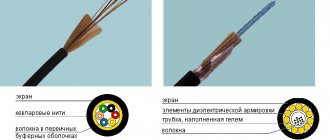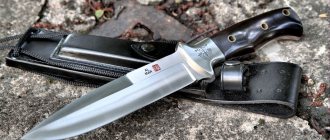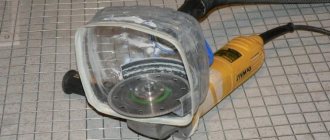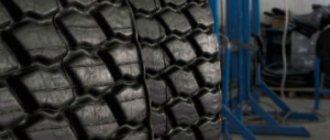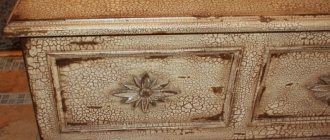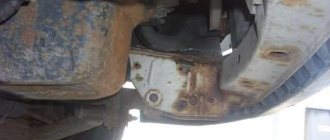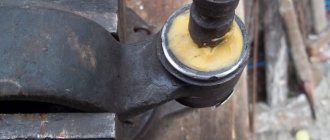Most modern synthetic cables used in yachting have a structure that is a braid enclosed in a braid (English term double braid). They have a number of advantages over cables of other designs, the most important of which are high resistance to torsion under load and softness with unchanged strength characteristics. In this lesson I will tell you how to splice such a cable. In principle, there are two main ways of splicing a braided cable with a core, and each of them has its own advantages and disadvantages. The advantages of this method are ease of execution; it can be performed on cables with different ratios of core and braid volume, but the disadvantages are that the connection increases the diameter of the cable (which must be taken into account when it passes through blocks and stoppers) and is not used on cables of other designs.
So to make the connection we need:
Two pieces of cable one and a half meters long, or one three-meter long as in my case (then you will get a closed loop), a pile of suitable diameter, a knife, adhesive tape, a marker, well, and something on which you can cut the cable without causing significant damage to property :) )
To begin, as usual, prepare the ends of the cable to be connected by wrapping them with adhesive tape and cutting off the welds if the ends are melted. Then let's start marking the braid:
From the beginning of both connected cables, set aside the length of the pile and mark this place with a marker and call it point R.
From it we will step back the length of the short part of the pile and also mark it as point X. For convenience, it is better to make marks on both ends being connected at once.
Stepping away from it another five lengths of the pile, we will tie a knot. Let's repeat the same with the second end. Then, using a pile at points X, carefully remove the cores from both ends, trying not to damage them. Secure the ends of the cores with adhesive tape.
Now let's mark the cores: We wrap the braid on both cables starting from the knot to the end and mark its exit from the braid by drawing a ring line with a marker. This is "point 1".
From it towards the node, having previously moved the braid towards the node, set aside the length of the short part of the pile and mark the place with a double ring line. This is point 2.
Let's move the braid further and put the length of the pile and its short part on the core. This is “point 3”. Let’s mark it with a triple ring line. Let's repeat what we did with the second cable.
Let's move on to the braid again: From point R towards the end, count 8 strands and mark this place. This is Point T. From it towards the end, mark 6 pairs of strands every other, as shown in the photo. Let's repeat the operation on the second braid. The markings are done.
Carefully remove the marked strands from the braid.
And we will cut them, narrowing them, thus ending the braid.
Let's repeat the same with the second braid. Now let's proceed directly to the connection:
Fix the end of one of the braids in the pile and insert it into the opposite core at point 2.
Let's bring it out at point 3.
Let's repeat the operation with the second braid.
The T points on both braids should remain outside. Let's grab the ends of the braids brought out at the point where they exit to the opposite cores.
Now let's deal with the cores: Let's fix the end of one of them in the pile, insert it into the opposite braid at point T and bring it out at point X.
Let's repeat on the second core.
Remove the tape and carefully smooth out the joints of the braids and cores from the connection points to the sides. The ends of the braids will “hide in the cores.
Let's move both braids from the nodes towards the connection. The joints should go under the braid.
All that remains is to tighten the connection, trim the outward ends of the core,
And once again, after tightening it well, finish. Thus obtaining a reliable, equally strong mold. Thank you for your attention and see you again.
How to braid a cable: diagram and step-by-step instructions
Any rope or cable, although it is made of good quality and strong steel, can unravel or even break at any moment. Despite the apparent complexity of the repair, it can be done by anyone, even those without special skills. The most unpleasant thing in the current situation is the possibility of a collision with it anywhere and precisely when such an accident is absolutely not expected.
Therefore, it will be useful to know how to properly braid a steel cable. Moreover, this does not require any special tools or special skills. In the future, it will be possible to weave both a hook and an earring into the cable. At the same time, the structural strength will be at a high level, and it will serve you for many years. It is advisable to wear protective gloves before starting work, as the sharp ends of the steel cable strands can seriously injure your hands.
Towing by muffler
What to do if the car is no longer new and the bracket has long been lost? Drivers usually try to find an alternative to attaching the cable to the intended location. In this case, it is right to be careful.
If you attach the cable to the suspension elements or weak parts under the bottom and pull strongly, then it is not surprising to completely immobilize the car. And if a section of the exhaust gas exhaust system is damaged or a lever is bent, expensive repairs will be required.
In addition, the cable is applicable in this case with the smallest maximum load, so that during sharp impacts it breaks and does not “bend” the metal. These tow ropes are similar to long and wide stripes of bright color. Their markings can be found in the manufacturer’s technical description.
General information about cables
In the field of agricultural and transport engineering, in the construction, oil and coal industries, in the areas of river and sea transport, ropes and cables made of stainless or ordinary, but at the same time reliable and durable steel are used. They are usually used as the basis for various transport, lifting and road mechanisms. If you look closely at a steel rope, you will notice that it is a flexible metal product consisting of strands of steel wire twisted together. The number of strands in each individual cable can be different, as well as the number of wires from which each of them is twisted. A zinc or aluminum coating is often applied to the cable over the strands, which improves its anti-corrosion qualities. A galvanized pipe (or a stainless steel equivalent) coated with such a special compound will last much longer than without it. If you don't know how to braid a steel cable, the diagram below will definitely help you.
Inside a steel rope there is usually a core, the main task of which is to prevent transverse deformation from developing in the product and preventing twisted strands of wire from falling toward the center. This is a mandatory attribute of any rope or cable made from organic, metal, natural or synthetic materials. In other words, the core is the internal framework for its strands. Knowing the structure of steel ropes or cables will help you understand how to properly braid a cable yourself.
Option 1
Well, congratulations on purchasing a synthetic rope. Now all that remains is to fix one end of the cable on the winch drum, and hang a hook on the other end. And if the first task is quite easy to cope with, then the second puzzles many and forces them to tie all sorts of knots and tighten the ends of the cable with metal clamps. This is wrong and unreliable. Below is a description of the braiding technology...
We cut the end of the cable at an acute angle, wrap the cut end tightly without creases with tape so that it does not become shaggy.
Next, we take the thimble and place the cable in its groove. The free end of the cable should be about 30-35 cm.
To seal the first loop, squeeze the cable crosswise and pass the sealed end into the resulting hole.
We make the second loop in the same way. The distance is about 5 centimeters. We braid the remaining end. The length of the stitches is about 5 centimeters.
We fold a little more cable and pass it inside. We remove the rest of the cable inside the braid...
We fold a little more cable and pass the embedded end of the cable inside. Preferably without folds.
Now you need to pull the embedded end of the cable out. You can help yourself with pliers. All that remains is to remove the tape and tighten the cable. The free end will hide inside.
The cable is ready!
Types of cables by degree of flexibility
There are steel cables:
1. With increased flexibility. In them, 24 wires are twisted around each core. There are 144 such thin wires in total.
2. With standard flexibility. Twelve wires are located around the core. There are a total of 72 wires in such cables.
3. Low-flexible cables. Only 42 wires are used in their production.
Types of cables according to lay direction
1. Cross - strands are twisted into a cable in the direction opposite to the direction of laying of the wire. 2. Unilateral - the direction is the same. 3. Triple - type 1 lay is used, but the wires and strands are twisted in different directions. 4. Combined - in such products, left- and right-hand directions of lay are simultaneously used.
In addition, cables are divided into rotating and low-twisting. The material from which the core is made also divides them into organic, single strand or steel wire.
Now you can consider in detail how to braid the cable yourself. Tools needed to complete the job:
- screwdriver;
- pliers;
- wire cutters;
- metal scissors;
- wire;
- gloves.
Tools
For work you need: a pair of worn flat screwdrivers with “clogged” edges, one of which is sharpened “to a cone”, pliers, or better yet, tongs, a hammer, a roll of masking tape and gloves. It is very advisable to have in addition a small angle grinder with a cutting disc and a solid vice.
An example of sharpening screwdrivers, hereinafter referred to as “piles”.
For example, they work like this. Preparing to punch the first strand.
How to braid a rope?
1. We cut off the ends of the cable as evenly as possible, and if the ends of its strands are bent or uneven, then we unravel each strand a little and cut off the defective areas with scissors or wire cutters. It is convenient to chop off the ends by placing them on a metal rail or on a sledgehammer and striking the same place with the sharp edge of a hammer. As a rule, after 10-15 such blows, the ends of the cable are cut off. 2. Unravel the cable into strands at least half a meter from the edge. 3. We determine the diameter of the future loop we need and, measuring this distance from the edge of the unbraided cable, take 2 strands. You need to add 3-5 cm to the diameter of the future loop, since it will definitely decrease in size when weaving. We make a loop from the selected strands, wrapping them. 4. Either end of the thread is untwisted and wound into intertwined strands. The other one needs to be wound in the opposite direction. If the length allows, then from the resulting three strands you can weave a pigtail, alternately weaving the threads. 5. The third strand is twisted around the braid, then a loop is woven into it, and a turn is made around the braid again. During the weaving process, the wires are passed in such a way that the previous one always goes towards the next one. 6. Then all the ends of the wires are hidden inside the pigtail, and the resulting two strands are hidden inside using a screwdriver or pliers. 7. It is advisable to tighten the resulting braid with clamps in two or three places. You can use ordinary wire, which is tightly wrapped around the cable and then pulled tightly with pliers. The protruding ends of such a clamp are also hidden inside the pigtails so that they do not interfere.
At the end of the work, it is advisable to isolate the location of the operation, for example, with insulating tape. It will help to fasten the ends of the steel wires together and will prevent future damage to the hands of the person who will use this cable.
When talking about how to braid a cable, you should remember: in order to get a strong and reliable connection, during laying it is necessary to lay the strands symmetrically and apply even pressure on them. Periodic crimping of the twisted strands will be an additional guarantee that the entire structure will receive sufficient strength.
Products – Tekhmashholding – group of companies, official website
- A wedge cable clamp is a special device whose purpose is to firmly connect the cables to each other. It can also be used to make a loop at the end of the same cables. But what else do you need to know about these elements?
Why is this detail in construction?
Typically, such devices are used where work is carried out under heavy loads, so only high-strength and high-quality metals are always used for the manufacture of clamps. Manufacturers produce these devices strictly in accordance with standards. The design of the clamps is very simple. They consist of two hex nuts and a steel bow. Professionals recommend installing at least three clamps on one cable; this is enough for safety and reliability of fastening. If the load is higher than the clamps you have chosen can withstand, then you should take a different type of this clamp rather than increase the number. Only high-quality and high-strength steel is always used for production. This is necessary to ensure a reliable connection at both ends of the elements. For greater reliability and strength, the clamps are often additionally coated with another protective layer. For these purposes, galvanic galvanization is used. The advantage is that with its help the device is provided with maximum resistance to external environmental influences. It is also excellent protection against corrosion. Although the design of this device is simple, you still need to read the instructions before use. Any tool or device has its own nuances that must be taken into account in the work. If the steel cable clamp is not installed correctly, the element may simply break. The end of the cable is inserted into the arc and secured inside using a special lock, in this case hex nuts. The nuts are twisted in different directions, and the cable will be between them. When fully twisted, the ends should be tightly pressed together.
Steel cable clamp - classification
Clamps come in different types. They are divided according to purpose, material used and design. You can also formally designate different lengths; the most popular is a cable clamp of 3 mm, 5 mm in diameter, but in special cases sizes up to 40 mm are used. Each species also has different subspecies. Clamps, which are divided according to purpose, are ordinary and reinforced, and according to the material used - steel and copper; an aluminum cable clamp is also popular; a galvanized steel version is used in particularly harsh operating conditions. Clamps, which are divided by design, are flat, arc-shaped, single and double. Regular clamps are the most common. Typically, they are made from galvanized steel of class 2. In appearance, such clamps resemble closed loops at the base, which have two strong bolts. This type of product is for household use and is not intended for heavy loads. The reinforced version speaks for itself, its design is more thoroughly worked out, the shutter mechanisms are reinforced, and therefore the scope of their application may be more responsible. Flat types of clamps are often made of high-strength carbon steel. The surface of these devices is galvanized. Their diameter can range from 2 to 40 mm. In shape, such clamps resemble a pair of plates that are connected to each other with a bolt and nut. They are typically used for splicing steel cables or other standing rigging. They are also quite suitable for creating loops at the end of the brace. Professionals recommend installing at least two clamps on one connection. Flat clamps can also be divided into single or double. The main difference is the number of bolts available. Single clamps are fastened with one bolt, and double clamps are fastened with two bolts. In terms of application, such clamps do not differ much. Arc-shaped clamps are made of a cylinder that is bent in an arc, and fastening occurs using two bolts that are located at the ends. Devices of this type are most often used for connecting metal cables, but it is quite possible to use them for making loops. This type of clamps is more industrial; they are designed for heavy loads. A typical standard arc clamp can withstand a load of about 97 kilograms.
Specialized and wedge clamps - what are their features?
Many construction jobs cannot be done without a strong clamp. Construction has always been characterized by the presence of a large number of operations. You definitely need to lift something up, pull a load, and in this case it’s building materials; you often have to fix various objects. For such work you need strong spring-loaded clamps. Not only do they allow you to connect the cables, but you can also attach a load to them. Such devices are not very different from standard clamps. In addition to the usual metal arc, they have a pair of levers that are equipped with movable brackets. This design solution helps ensure a highly durable and durable connection. With its help, you can securely fasten any object to a cable of different thickness. Lately, wedge clamps have become the most popular among specialists. This is an excellent connecting element for copper and aluminum wires, the cross-section of which can range from 35 to 100 square millimeters. Only this type of clamp is good for connecting steel-aluminum devices. Such devices consist of a body and a wedge, which is wear-resistant. For the manufacture of the body, forged cast iron steel is used, and the wedge itself can be made of bronze or from various aluminum alloys. If you need to install aluminum or steel-aluminum wires in bolt clamps, where the cross-sections are very large, then you need to use special gaskets that are made of soft aluminum tape . The use of such an addition in work will give the fastening the greatest mechanical strength. It is important to remember that after installation, such clamps must be tightened again ten days later. The lift should be done like this. The first step is to press the hinge part of the aluminum housing, then you need to insert a steel anchor, and then the aluminum housing is inserted again using a steel mechanism.
How to make cable clamps with your own hands?
Cable clamps are used in many industries. There is no industry where they would not find application. But often ordinary household work cannot be done without such a small device. Car owners especially need them. You will need a small diameter metal tube, a couple of metal plates and several bolts and nuts. The metal tube must be bent into an arc. The diameter of the pipe must be such that the cable that is planned to be used can fit into it. A cable must be inserted into the hole in the pipe until the end appears outside. Then the end must be pulled out of the pipe to a distance of 10-15 cm, then the end of the cable and the cable itself will need to be covered with plates from below and above, and the plates must be tightly connected to each other using strong bolts. This device is well suited for making loops. If you need to connect two cables to each other, then you need to choose a tube with a larger diameter. It must be taken into account that two cables need to be inserted into one hole, but only in different directions. The plates are also selected taking into account the diameter of the cables. Such a clamp will always come in handy in household chores, just keep in mind that it is not suitable for heavy loads, but it is quite possible to try to use it as a tug.
Source: https://pellete.ru/stal/kak-zavyazat-tros-stalnoj.html
Making a loop on a steel cable
Often, in addition to solving the problem of “how to braid a cable,” the need arises to form a loop at its end. For example, when repairing a guy wire on a tow rope or on an antenna, it becomes necessary to lower something to a depth, such as a submersible pump. Since the steel cable or rope is quite rigid, simply tying it with a knot at the end will not work. In this case, there is nothing else left to do but braid the cable into a loop. And there is nothing complicated about this either. The same goes for braiding a cable with steel wire.
Tying the ropes with a snake knot
The snake knot is another option used to connect two ends. It is used for nylon threads and has high reliability. The second name is bloody. It is justified by the fact that in the past the knot was used to tie a noose on the gallows.
To tie a knot you need:
- arrange the ropes parallel;
- loop the end of one rope around the other through the top three times;
- do the same for the other rope, except that here you need to circle through the bottom;
- thread the ends into the ring formed between the ropes;
- Pull the base of the ropes, after which the knot will be easily tightened.
Work process
1. The ends of a regular seven-strand cable are cut evenly with a grinder or chopped off with a hammer (its sharp part). 2. Unravel the cable by 50-70 cm and use a screwdriver to divide it into two parts. One produces three strands, and the other four. 3. We twist the strands of both parts together. 4. Make a loop with a diameter of at least 10 cm. 5. Bend the first four-strand part towards the other, which we place in the bends of the main cable. 6. We twist the ends of the woven threads one by one around an improvised handle. 7. Then we twist each free strand in turn around the handle, weaving it into a loop, and repeat the process. 8. After this, placing the next one on the previous one, we cover the ends of all strands. As a result of such manipulations, we get two threads that need to be placed between the loops using a screwdriver. In this place it is better to seal it with pieces of pipes, flattening them, or use insulating tape. This will help avoid injury in the future.
Introduction
Factory fastening option
Unlike a rope, a steel cable is very difficult, almost impossible, to tie to the attachment point. For this purpose, special hooks, carbines and other devices are used.
But in order to attach them to the cable, the latter must have a loop at its end. The issue can be resolved as follows:
Action No. 1 Marking the cable
Marking the end of the loop with tape
First, you need to estimate the approximate dimensions of the loop by bending the end of the cable and marking the place of its contact with the cable. This can be done using tape or insulation.
Action No. 2 Unraveling the end of the cable
It is necessary to separate three threads using a screwdriver
1
The cable must be unbraided from its end to the mark made using a screwdriver. This is quite easy to do. Typically, the cable consists of 6 woven threads.
And begin unraveling the cable by rotating one of the groups of threads in a clockwise direction
2
The process continues until the point marked with tape is reached.
Unraveling the cable until it reaches the point marked with tape
3
The process continues until the point marked with tape is reached.
Cable unbraided to the required length
Action No. 3 Formation of a loop
Cable prepared for loop formation
1
One of the resulting groups of threads remains in a straightened position, while the other is bent until its end touches the marked point.
Connecting the woven threads at the midpoint
2
Approximately halfway from the end of the cable to the marked point, two groups of threads are connected so that they fit into the free spaces on each other.
Relatively long section of reconnected cable
3
Since the bundles of three threads are symmetrical, they fit into each other perfectly: the places where there is steel on one bundle fit into the voids on the other and vice versa.
Continue laying the cable along the entire length of the loop
4
In the same way, continue to lay the cable along the entire length of the loop.
The loop is ready, all that remains is to complete the braiding of its fixation point
Action No. 4 Fixing the loop
Loop formation
1
A screwdriver is inserted into the loop.
Scroll counterclockwise towards the taped point
2
And it is scrolled counterclockwise towards the point marked with tape.
Braided rope into a thicker one
3
In this case, the cable is independently woven into a thicker one, consisting of 12 threads.
The screwdriver is reinserted into the loop
4
Then the operation is repeated: the screwdriver is again inserted into the loop.
And again scrolls to the point marked with tape counterclockwise
5
If necessary, the procedure is repeated 1 or 2 more times.
The loop obtained as a result of weaving the cable is securely fixed
6
To prevent the ends of the threads from unraveling, they are fixed with electrical tape.
Secure with electrical tape
7
For more reliable fixation, a steel clamp is used.
A steel clamp is used for fixation
How to QUICKLY make a LOOP ON A STEEL ROPE with your own hands
How to beautifully and securely braid a rope into a loop: step-by-step schematic instructions
10 Total Score
How to braid a rope into a loop
Did you like our Lifehack?
10
Customer ratings: Be the first!
Fire on a rope or cable
Speaking about how to braid a cable - steel or from another material, we should also mention that you can make a fire. It's a little more complicated. At some distance from the end of the cable, a durable temporary mark is made, and the ends of its strands are secured with the same marks. After this, you should unravel the end of the rope.
In the form of a loop, the cable is laid on a surface (preferably hard), and all its strands are broken through. Several punches are made, but special attention is paid to the first one, since it is the most important of them. The reliability and strength of the fire is ensured mainly by the first punching. This is also an acceptable way to braid a cable. The scheme will not cause any difficulties.
We tie the ropes with a flat knot
An option for tying two ropes together is also offered by a flat knot. Its scheme is as simple as possible. To tie a flat knot you need:
- cross two ropes;
- tie one of the ropes around the other;
- repeat the previous step with the remaining ends of the rope (so that the ends of the first come out of the loop formed by the second rope).
- tighten the knot by pulling the ends of the ropes and then the warps.
There are many options for tying loops and fastening two ropes together. Each of them offers a similar result, but using its own features. High complexity of a node indicates greater reliability. Simple ones have their advantage in terms of speed, but cannot provide reliable fastening on all materials. The ability to properly tie knots may be needed not only for life insurance, but also for equipment repair.
How to tie a loop on a rope?
If for some reason you decide to try tying a loop, rather than unbraiding the cable and twisting the strands, as discussed above, then you can use an old sea knot, the simplest one - an oak one. The algorithm for this method of how to braid a steel cable is presented below:
- Fold the end of the cable in half and wrap it to form a ring.
- Thread the loop that has formed at the end into the ring and tighten tightly. The result is a strong and very reliable knot. Its main drawback is that when tensioned it tightens very tightly and then it is quite difficult to untie it.
Now you can repair the steel cable yourself, since you know how to braid the cable into a loop, and such a breakdown will not cause you much trouble in the future.
We tie the ropes with a weaver's knot
You can also use a weaving knot to tie two ropes together. It is also called textile, as it was originally used for fastening threads.
In order to tie such a knot as a weaving one, you will need:
- tie a simple knot at the end of one of the ropes, passing the end of the second through the loop formed from below, leaving a reserve length for safety knots;
- repeat the action with the second rope, but forming a loop on top;
- tighten the knot;
- form safety knots from the remaining ends in the same order.
Eight
This is a traditional knot used whenever you need to attach something to a rope. It is easy to knit, it can withstand heavy loads, and later such a knot can be quite easily untied to free the rope.
The Figure Eight knot has two options. The first is used in cases where you have one free end. It looks quite complicated, but once you figure out the sequence of actions just once, everything will work out by itself.
The second option can be used when both ends of the rope are free. This knot is so simple that you can tie it with your eyes closed, and at the same time it is completely secure.
We tie the ropes with a clew knot
The clew knot is used to fasten the two ends. Before tying a clew knot, it is worth remembering that its use on synthetic ropes is unsafe. Since synthetic fibers are slippery, the knot can come undone easily. The clew is used only for natural ropes that are under load.
In order to tie this knot, you need:
- fold the end of one of the ropes (on the left in the image) into a loop;
- pass the end of the second rope through the back side of the rope (in the image on the right);
- circle the left rope folded into a loop with the right rope;
- pass the end of the right rope into the loop formed by it.
Driver node
A truly legendary knot that has many different names and even more practical applications. This knot is used in construction work, during transportation, in tourism and other cases when you need to secure something tightly and tightly.
For those readers who find it difficult to navigate the animated drawings, there are additional instructions containing static photos of each step. You can find it at this link.
What other nodes do you consider practically useful and necessary to master?

